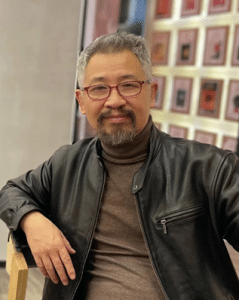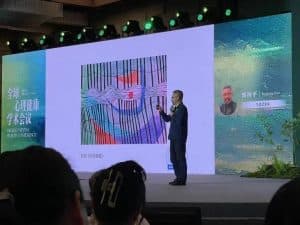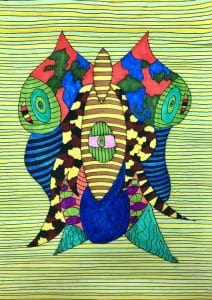The Nanjing Original Art Center (NOAC), established in 2015, is dedicated to promoting original art. The center provides services for people with mental disorders through various forms such as original art creation, experience camps, and lectures, helping them improve their mental health and living conditions.
Original art is an art form that relies on one’s instincts and nature, expressed through painting without professional training. Most of the artists at the Nanjing Original Art Center are people with mental disorders, and their works are full of unrestrained imagination and unique creativity.

Recently, CDB interviewed Mr. Guo Haiping, the founder of the Nanjing Original Art Center. Here are the details of the interview:
CDB: Please introduce yourself or your organization and what inspired you to incorporate original art into the rehabilitation process for people with mental disorders?
Guo: The Nanjing Original Art Center has undergone a complex development process. Initially, I sought to understand the true nature of the human spirit, feeling that what I observed in reality, even within the art world, seemed obscured and unreal. Although I wasn’t sure what constituted truth and reality, I trusted my intuition. In 2005, I invited 27 contemporary artists from across the country to participate in an exhibition called “Illness” at the Nanjing Art Museum. I asked them to abandon their past experiences and create works around the theme of “illness.” However, the results were unsatisfactory. Eventually, I turned to patients in psychiatric hospitals who had no artistic experience, believing that their lack of pretense and artistic background might reveal the truth I was seeking. The three-month experiment in the psychiatric hospital not only revealed the human spirit’s truth but also showed that this form of direct expression, devoid of professional art experience, had a surprisingly positive impact on the patients’ mental states.

In 2014, I was invited to give a keynote speech on the relationship between original art and mental illness at the Jiangsu Provincial Psychology Annual Conference. In 2015, the Changzhou Psychological Society invited me to conduct a practical training class on “Self-healing and Therapeutic Techniques in Original Art Creation.” Since then, I have focused on the role of original art in psychological rehabilitation. In fact, in 1989, I established the “Art Analysis Department” at the Nanjing Youth Psychological Counseling Service Center, recognizing art’s unique role in psychological healing. In 2019, China’s first textbook on “Social Psychological Occupational Therapy” included “Original Art Therapy Techniques” for the first time.
CDB: Can you describe the service model of your original art project and how you select and train participants?
Guo: Rather than calling it a service model, I prefer to call it a service philosophy. This philosophy follows Laozi’s principle of “governing by doing nothing,” which values nature. I believe that psychological problems arise when a person’s spirituality is obscured, and this obscuration is due to excessive human intervention. Once obscured, a person’s spirituality becomes isolated, mechanical, and passive, leading to mental health issues. To fundamentally address this, we need to remove the obscurations and liberate the person’s spirituality. Everything we do aims to achieve this goal.

Regarding participants, we have no uniform standards. If there are any, they are designed to facilitate this goal. For example, we create different courses for various groups such as patients, college students, social workers, and psychological counselors. All course designs are intended to help participants eliminate interference and allow their spirituality to express itself freely.
CDB: What significant changes have you observed in participants after participating in original art therapy?
Guo: Regardless of who the participants are, once they engage in the practice of original art, their hearts are touched to varying degrees. Some open up completely, while others partially. Once they open up, their hearts become less closed, allowing them to establish broader connections with the outside world. These connections lead to interactions, and through these interactions, their lives gain vitality, which is essential for healthy psychology. Another crucial point is that during the creative process, participants increase their awareness of their own spirituality. This awareness, known as “enlightenment” in Chinese culture, brings infinite vitality and vigor to their lives.
CDB: Can you share some personal success stories of those who have benefited from this project?
Guo: All 24 patients with various types of mental illnesses who have signed service agreements with us have undergone significant changes. For example, Yang Min, a patient with schizophrenia, used to relapse every one or two years before joining our studio. Each time he was hospitalized, he received seven or eight electroshock treatments. Since coming to our studio in 2014, he has not relapsed. His life, which was previously managed by his parents, now involves him taking care of his parents and other patients in the studio. He also welcomes guests and explains original art to them.

Another example is Xu Jian, who has an intellectual disability. Like Yang Min, his life used to be managed by his parents. Now, he handles most of the housework at home. Additionally, Hu Xinyi, an autistic patient, had no response to the outside world, no facial expression, and a stiff body when she first joined the studio eight years ago. Now, painting has become an essential part of her life, and her health has greatly improved. We often see smiles on her face, and she enjoys communicating with her family.
CDB: What are the biggest challenges you face in implementing this rehabilitation work, and how do you cope with them?
Guo: Despite 18 years of effort, many challenges remain. One major issue is that the public does not truly understand the real needs of this group and often imposes their own will on them. As one 15-year-old patient expressed, her parents constantly restrict her development in the name of love. Additionally, barriers between different government departments and professions make it difficult to form a cohesive support network. Conflicts of interest further complicate efforts, seriously affecting the level of support for these individuals. Another significant challenge is the lack of awareness regarding the importance of cultural and artistic methods for the development of people with mental disabilities, which directly impacts financial investment.

We cannot avoid these challenges or solve them quickly. I believe the most effective way to gradually change this situation is to continuously hold exhibitions to help people understand the unique wisdom and contributions of this group. Therefore, we often say, “Use time to exchange space” and “Living is winning.”
CDB: What are your future plans for the original art therapy project? Are there any new plans or expansions?
Guo: Last month, with support from the Nanjing Municipal Government and the Disabled Persons’ Federation, we established the Nanjing Original Art Center, spanning 1000 square meters. Our goal is for this center to serve purposes such as creation, research, collection, training, exhibition, and exchange. However, realizing these functions requires corresponding human and material resources. Recently, the Nanjing Disabled Persons’ Federation has been working on establishing the Original Art Foundation for us. Despite facing challenges, particularly due to the pioneering nature of our work in China without prior local precedent, we remain confident. More and more Chinese people are recognizing the significant value and importance of our efforts.
CDB: How can society better support people with mental disorders through art and other therapeutic methods?
Guo: Mental disorders often stem from neglecting the spiritual aspects of life. Spirituality, not easily defined by words, is nature’s wisdom bestowed upon human existence. When this individuality and fluidity of life are disregarded over time, conflict with conventional consciousness can lead to mental disorders. Art plays a crucial role by honoring life’s uniqueness and fluidity. Most art today merely conveys conceptual knowledge, which fails to truly respect spirituality. Original art, however, bridges this gap by making life’s invisible aspects visible, fostering a connection with human consciousness and awakening life. Effective methods for supporting mental health include any approach that promotes this awakening.
CDB: What aspect of working in this field gives you the most sense of accomplishment?
Guo: Gaining a new life. Witnessing the transformative power of original art therapy on individuals with mental disorders is profoundly rewarding. Seeing patients blossom creatively, regain confidence, and integrate more fully into their communities brings immense joy. Each person’s journey toward healing and self-discovery reaffirms the importance of our work and inspires me to continue pushing boundaries in this field. Knowing that we are making a tangible difference in improving lives fills me with a deep sense of accomplishment and purpose.

Conclusion:
At CDB, we are deeply inspired by Mr. Guo’s pioneering work at the Nanjing Original Art Center. His dedication to integrating original art into mental health rehabilitation has not only transformed individual lives but also challenged societal perceptions of mental disorders. Guo’s insights into spirituality and the profound impact of art therapy highlight the potential for creative interventions to foster healing and resilience.
Moving forward, CDB remains committed to supporting initiatives like the Nanjing Original Art Center that prioritize holistic approaches to mental health. By promoting understanding and advocacy, we aim to create a more inclusive society where individuals with mental disorders can thrive and contribute meaningfully. Together with innovators like Mr. Guo, we look forward to advancing these efforts and expanding opportunities for artistic expression in therapeutic settings.



